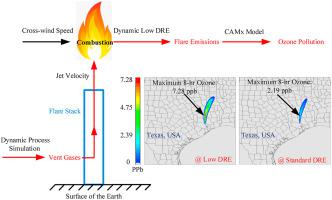Atmospheric Environment ( IF 4.2 ) Pub Date : 2021-04-11 , DOI: 10.1016/j.atmosenv.2021.118399 Sijie Ge , Sujing Wang , Qiang Xu , Thomas Ho

|
The destruction and removal efficiencies (DREs) for industrial flare combustion could be, in reality, less than the supposed standard values of 98%/99% because of various atmospheric and plant operating conditions. Thus, flaring during chemical plant shutdown (CPS) under low DREs would release larger quantities of VOCs and NOx than expected, which might rapidly worsen the regional ozone pollution under solar radiation. Therefore, it is vital to examine the quantity and sensitivity of ozone impacts owing to low DREs for flare combustion rather than standard values. In this paper, effect of dynamic low DREs on regional ozone impacts during CPS flaring has been systematically conducted by coupling Aspen Plus with CAMx modeling and simulation. Case studies indicated that 8-hr ozone caused by CPS flaring under low DREs could range from 6.08 to 7.28 ppb, which was much greater than that based on the standard DREs ranging from 1.8 to 2.19 ppb. This study also demonstrated that the 8-hr ozone increment could be significantly reduced from the maximum of 6.14 ppb to the minimum of 0.85 ppb by starting the CPS operations at the optimal time. Another important finding was that ozone impacts might slightly increase with the increase of flare stack height due to meteorological conditions including high wind speed and strong solar radiation. This study would provide scientific support for quantitative ozone evaluation caused by CPS flare emissions, which will enrich future solutions for cost-effective regional air-quality management and ozone pollution control.
中文翻译:

火炬燃烧产生的动态低DRE对化工厂关闭期间对区域臭氧污染的影响
实际上,由于各种大气和工厂操作条件,工业火炬燃烧的破坏和清除效率(DRE)可能会低于假设的标准值98%/ 99%。因此,在低DRE下化工厂停工(CPS)期间燃烧会释放出大量的VOC和NO x超出预期,这可能会迅速加剧太阳辐射下的区域臭氧污染。因此,至关重要的是检查由于火炬燃烧的DRE低而不是标准值所致的臭氧影响的数量和敏感性。在本文中,通过将Aspen Plus与CAMx建模和仿真相结合,系统地进行了动态低DRE对CPS燃烧过程中区域臭氧影响的影响。案例研究表明,在低DRE下由CPS燃烧引起的8小时臭氧范围为6.08到7.28 ppb,比基于标准DRE在1.8到2.19 ppb范围内的臭氧高得多。这项研究还表明,通过在最佳时间启动CPS操作,可以将8小时的臭氧增量从最大6.14 ppb降低到最小0.85 ppb。另一个重要发现是,由于气象条件(包括高风速和强烈的太阳辐射),随着火炬烟囱高度的增加,臭氧的影响可能会略有增加。这项研究将为由臭氧引起的定量臭氧评估提供科学支持。CPS的火炬排放将丰富未来的解决方案,以实现具有成本效益的区域空气质量管理和臭氧污染控制。











































 京公网安备 11010802027423号
京公网安备 11010802027423号